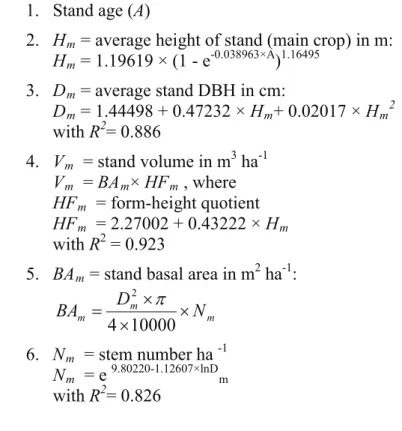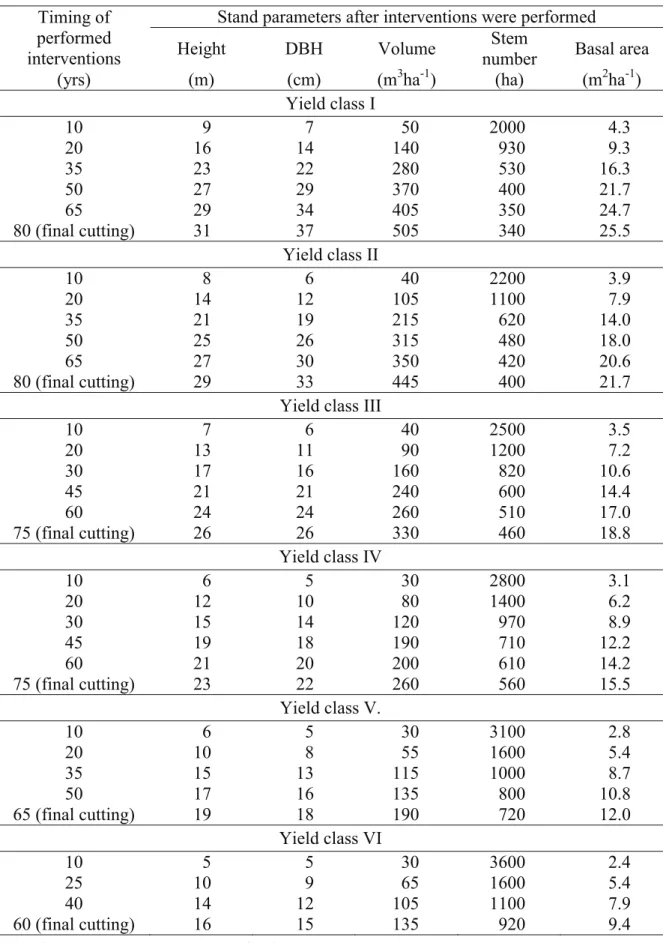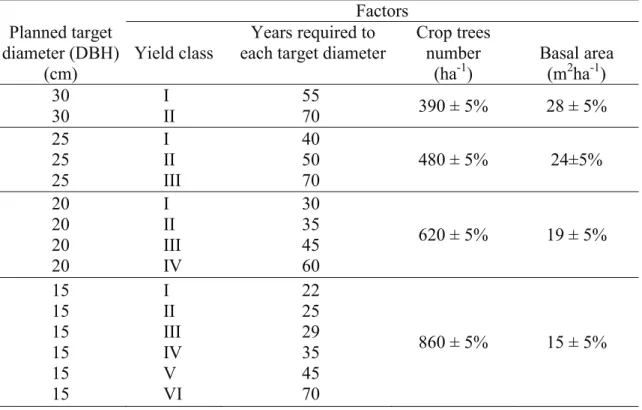Tending Cutting and Target Diameter Tables for Northern Red Oak ( Quercus rubra L.) Stands in Hungary
Károly R
ÉDEIa– Imre C
SIHAb– János R
ÁSÓb– Csaba K
OVÁCSb– Beatrix B
AKTIb– Tamás K
ISSb– Zsolt K
(6(5ĥb*aFaculty of Agricultural and Food Sciences and Environmental Management, University of Debrecen, Debrecen, Hungary
bForest Research Institute, National Agricultural Research and Innovation Centre, Püspökladány, Hungary
Abstract– In addition to black locust (Robinia pseudoacacia L.) and hybrid poplars, northern red oak (Quercus rubra L.) can be considered the third most important exotic stand-forming tree species in Hungary. Due to its advantageous silvicultural and growth characteristics, as well as its wood utilization possibilities, the present area northern red oak stands occupy in the country amount to 15 thousand hectares. This study presents a new, simplified tending cutting table for northern red oak stands as well as an age-target diameter table suitable for quality log production within a rotation period of generally 80–85 years. The simplicity of the practice-oriented tables based on a relevant yield table may further the qualitative development of northern red oak management and wood utilization.
Northern red oak / silviculture / management guideline / Hungary
Kivonat –(UGĘQHYHOpVL pV FpOiWPpUĘ WiEOiN D PDJ\DURUV]iJL Y|U|V W|OJ\ Quercus rubra L.) állományokra.A fehér akác (Robinia pseudoacacia L.) és a nemes nyárak mellett, Magyarországon a KDUPDGLNOHJMHOHQWĘVHEEH[yWDIDIDMQDNWHNLQWKHWMNDvörös tölgyet (Quercus rubra /.|V]|QKHWĘHQ HOĘQ\|V HUGĘPĦYHOpVL pV Q|YHNHGpVL WXODMGRQViJDLQDN YDODPLQW IDKDV]QRVtWiVL OHKHWĘVpJHLQHN jelenleg az orV]iJEDQ D Y|U|V W|OJ\ iOWDO HOIRJODOW WHUOHW QDJ\ViJD H]HU KHNWiUUD WHKHWĘ -HOHQ WDQXOPiQ\ D Y|U|V W|OJ\ iOORPiQ\RN ~M HJ\V]HUĦVtWHWW IDiOORPiQ\ QHYHOpVL YDODPLQW NRU-FpOiWPpUĘ WiEOi]DWDLW N|]OL D PLQĘVpJL U|QNWHUPHV]WpV ILJ\HOHPEH YpWHOpYHO – 85 éves átlagos vágásfordulóval. A releváns fatermési táblán alapuló, gyakorlat-RULHQWiOW WiEOi]DWRN HJ\V]HUĦVpJH HOĘVHJtWKHWLDY|U|VW|OJ\JD]GiONRGiVpVIDKDV]QRVtWiVPLQĘVpJLIHMOHV]WpVpW
vörös tölgyHUGĘJD]GiONRGiVJD]GiONRGiVLLUiQ\HOY0DJ\DURUszág
1 INTRODUCTION
Northern red oak (Quercus rubra L.) was introduced from North America to Europe in 1691 and currently covers over 350 thousand ha (Nicolescu et al. 2018). It appeared in Hungary in the middle of the 19th century and has adapted in large measure to site conditions in the country. Due to its advantageous silvicultural and yield characteristics, it now occupies an area of approximately 15 thousand hectares. The most important growing areas are in Baranya, Vas, Zala, Somogy and Szabolcs-Szatmár-Bereg counties (Járó 1957, Rédei et al. 2007).
Northern red oak is a fast-growing species, and its seedlings and saplings emerge quickly from weed competition. During northern red oak tending operations, it is important to consider that its populations consist of varied genetic value specimens (genotypic), ranging from early to late flushing, and from more light-demanding to more shade-tolerant.
Northern red oak produces a well closings and favourably differentiated stand structures due to the great genetic diversity of individual trees (Szappanos – Nagy 1978, Rédei et al.
2010). Northern red oak utilizes the leaks of thinnings well. The individual selective method can be combined with frequent stem number reductions. Integrated systems of northern red oak silvicultural treatments have been not completely elaborated yet because very few northern red oak stands at final rotation age (at about 80-90 years) presently exist.
Advances in both research and practical experience have helped develop tending techniques for northern red oak. A grouping of forest silvicultural treatments to form a tending model can be made based on the results of long-term stand structure and forest yield trails. This greatly aids in the measuring, prescribing, and controlling of tending cuttings.
2 MATERIALS AND METHODS
The models we developed are based on our yield table for northern red oak of seed origin (Rédei et al. 2007). The table was created from data gathered from 100 experimental plots.
The stands sampled were located from N 20°33’ and E 48°00’. The main ecological characteristics of the sample plots region are the following: forest-steppe climate where the relative air humidity is between 50 and 55%; hydrology: free draining; dominant soil type:
humus sand soil; annual precipitation varies between 500 and 550 mm. Stand ages varies from 5 to 70 years. Distribution of the measured stands by yield (site) class:
Yield class Number of stands Age group (years) Number of stands
I. 35 5–10 12
II. 26 11–20 25
III. 12 21–30 28
IV. 11 31–40 13
V. 8 41–50 10
VI. 8 51–60 6
61– 6
The key stand characteristics were measured during the tree stand surveys; major stand structure features such as average height, breast height diameter, volume, basal area, and stem number – given separately for the main, secondary and total crops per hectare – were all calculated based on the data collected (Laar – Akca 2007, Pretzsch 2009). A computer-based statistical programme (SPSS 2005) calculated the regression analyses.
The expected height values of the stands at the reference age (50 years) according to six yield classes are the following: 27.0 m, 24.6 m, 22.2 m, 19.8 m, 17.4 m, and 15.0 m. Based on the guide curve and the reference age (100%), a percentage value was calculated at any age and for any yield class. The yield table was constructed using the following formulae and coefficients (Rédei et al. 2007):
1. Stand age (A)
2. Hm= average height of stand (main crop) in m:
Hm= 1.19619 × (1 - e-0.038963×A
)1.16495 3. Dm= average stand DBH in cm:
Dm= 1.44498 + 0.47232 × Hm+ 0.02017 × Hm2 with R2= 0.886
4. Vm = stand volume in m3ha-1 Vm =BAm×HFm, where HFm = form-height quotient HFm = 2.27002 + 0.43222 × Hm
with R2= 0.923
5. BAm= stand basal area in m2ha-1:
m m
m D N
BA u
u u 10000 4
2 S
6. Nm = stem number ha -1 Nm = e 9.80220-1.12607×lnD
m
with R2= 0.826
3 RESULTS
3.1 Simplified tending cutting table for northern red oak stands
Table 1 contains a tending cutting model for northern red oak stands. The table was compiled using data obtained from 100 long-term yield plots, of which 95 have had experimental interventions as well. The table presents the data in six yield classes. Tree height is an important factor because it determines the timing of a particular cleaning/thinning. The stem number quoted in the table is another basic parameter in the course of planning the interventions.
The optimum time to apply release treatments in young northern red oak stands is when the canopy begins to close, and to continue the treatments for about 10 years after canopy closure. The stand age at canopy closure varies with site quality. On higher quality sites, where relatively abundant resources accelerate stand development, canopy closure can occur at about 8 to 10 years. On poorer sites, where stand development is slower, canopy closure can occur somewhat later.
As northern red oak is a fast-growing species, cleaning-respacing (normally two interventions) in dense stands starts relatively early in order to preserve large canopies, but also to help the natural pruning of red oak trees. Stocking at the completion of cleaning- respacing (meandiameter ca. 9-12 cm) should not exceed 1,200-1,600 trees ha-1. In general, a negative selection that removes undesired individuals, such as supressed and forked trees, from very dense areas is performed.
Commercial thinnings in northern red oak stands are selective all over Europe,and they should start before dominant height reaches 13-14 m (Nicolescu et al. 2018). The task of achieving high diameter growth rates for northern red oak trees can be fulfilled by the application of an intensive crop-tree silviculture utilizing positive selection that targets the free-growth state of final crop trees at the crown level. The final crop trees are selected based
Table 1. Tending regimes for northern red oak stands Timing of
performed interventions
Stand parameters after interventions were performed
Height DBH Volume Stem
number Basal area
(yrs) (m) (cm) (m3ha-1) (ha) (m2ha-1)
Yield class I
10 9 7 50 2000 4.3
20 16 14 140 930 9.3
35 23 22 280 530 16.3
50 27 29 370 400 21.7
65 29 34 405 350 24.7
80 (final cutting) 31 37 505 340 25.5
Yield class II
10 8 6 40 2200 3.9
20 14 12 105 1100 7.9
35 21 19 215 620 14.0
50 25 26 315 480 18.0
65 27 30 350 420 20.6
80 (final cutting) 29 33 445 400 21.7
Yield class III
10 7 6 40 2500 3.5
20 13 11 90 1200 7.2
30 17 16 160 820 10.6
45 21 21 240 600 14.4
60 24 24 260 510 17.0
75 (final cutting) 26 26 330 460 18.8
Yield class IV
10 6 5 30 2800 3.1
20 12 10 80 1400 6.2
30 15 14 120 970 8.9
45 19 18 190 710 12.2
60 21 20 200 610 14.2
75 (final cutting) 23 22 260 560 15.5
Yield class V.
10 6 5 30 3100 2.8
20 10 8 55 1600 5.4
35 15 13 115 1000 8.7
50 17 16 135 800 10.8
65 (final cutting) 19 18 190 720 12.0
Yield class VI
10 5 5 30 3600 2.4
25 10 9 65 1600 5.4
40 14 12 105 1100 7.9
60 (final cutting) 16 15 135 920 9.4
Remarks: Data over 70 years are extrapolated.
3.2 Age, growing space, and target diameter table for northern red oak stands
As partly mentioned earlier, the timing for the expansion of the available growing space by maintaining the near optimal stem number and basal area per hectare is vital to attain the target assortments. Ecological site factors also essentially define the target assortments (Savill et al. 1997).
The data in Table 2 show that an opportunity for the production of quality, sizeable logs is possible in northern red oak stands in yield classes I-III (DBH > 25 cm). In yield class IV, the 20 cm-target diameter can only be expected when the stand reaches the age of 60 years.
Depending on the yield class, the sustainable stem number varies from 390 to 620 stems per hectare.
Table 2 also illustrates that stands of yield classes V and VI are suitable for the production of mass assortments (cutting, pallet, box basic material, pulp, fibre, chippings, and basic wooden board materials). However, the stands characterised by these two lowest yield classes are usually loss producing, and are thus unsuitable for plantation forest management.
Table 2. Age-target diameter table for northern red oak stands Planned target
diameter (DBH)
Factors Yield class
Years required to each target diameter
Crop trees
number Basal area
(cm) (ha-1) (m2ha-1)
30 30
I II
55
70 390 ± 5% 28 ± 5%
25 25 25
I II III
40 50 70
480 ± 5% 24±5%
20 20 20 20
I II III IV
30 35 45 60
620 ± 5% 19 ± 5%
15 15 15 15 15 15
I II III IV V VI
22 25 29 35 45 70
860 ± 5% 15 ± 5%
4 CONCLUSIONS
Q. rubra was first brought to Europe in the 17th century primarily for ornamental purposes and out of botanical curiosity. Northern oak is quite common as it was planted in numerous botanical and residential gardens and was used as a roadside tree. Towards the end of the 18th century, European foresters recognized the successful acclimatisation, large ecological amplitude, fast growth, and suitable wood properties of this tree species, all of which initiated its widespread introduction into timber forests. At present, Q. rubra is a commercially important tree and one of the most frequent deciduous species of foreign origin found in European forests.Q. rubrais an important source of hardwood timber for the wood industry.
As the present study demonstrates, the number of crop trees released within northern red oak stands varies depending on site quality, species composition, stand age, and management objectives. Total volume production per unit area between thinned and unthinned stands does not differ greatly.
In recent decades, growth models for different tree species based on stand level data have gradually been replaced by stand growth models predicated on stem number frequencies and individual tree growth models (Pretzsch 2009). Nevertheless, traditional silvicultural models will remain very useful tools for forest management and forest inventory. The published tables can be widely used in northern red oak management and inventory tasks including harvest scheduling, growth analysis, and volume estimates. The tables can also serve the further development of silvicultural (thinnings) models and the development of guidelines for local policies promoting plantation forestry.
Acknowledgement: The authors would like to thank D. Houlihan (Timberland Forestry, Ireland) for improving the English version of the text.
REFERENCES
JÁRÓ, Z. (1957): A vöröstögy növekedési viszonyai. [Conditions of Growth of the Red Oak.@$](UGĘ 6 (2): 63–67. (in Hungarian)
LAAR, A.V. – AKÇA, A. (2007): Forest Mensuration. Springer, Dordrecht.
NICOLESCU, N.V. – VOR, T. – MASON, W.L. – BASTIEN, J.C. – BRUS, R. – HENIN, J.M. – KUPKA, I. – LAVNYY, V. – LAPORTA, N. – MOHREN, F. – KRASIMIRA, P. – RÉDEI, K. – Š7()$1ý,., I. – WĄ6,., R. – P(5,û, S. – HERNEA, C. (2018): Ecology and management of northern red oak (Quercus rubra L. syn. Q. borealis F. Michx.) in Europe: a review.
Forestry.https://doi.org/10.1093/forestry/cpy032.
PRETZSCH, H. (2009): Forest Dynamics, Growth and Yield. Springer, Berlin.
RÉDEI, K. – VEPERDI, I. – CSIHA, I. (2007): Yield of red oak stand in the Nyírség forest region (Eastern Hungary). Silva Lusitana 15 (1): 79–87.
RÉDEI, K. – CSIHA, I. – K(6(5ĥ, ZS. – RÁSÓ, J. – G<ė5,, J. (2010): Management of red oak (Quercus rubra L.) stands in the Nyírség forest region (Eastern Hungary). Hungarian Agricultural Research 19: 13–17.
SAVILL, P. – EVANS, J. – AUCLAIR, D. – FALCK, J. (1997): Plantation silviculture in Europe. Oxford University Press, Oxford.
SSP– Smith’s Statistical Package Version 2.8. Pomona College. CA. 2005.
SZAPPANOS, A. – NAGY, S. (1978): Faállomány-szerkezeti vizsgálatok tisztítási korú vöröstölgyesekben. [Examination of constitution of stands of young red-oak-woods.] Erdészeti és Faipari Egyetem Tudományos Közleményei 23–37. Sopron. (in Hungarian)


